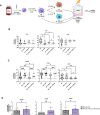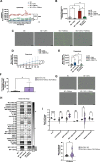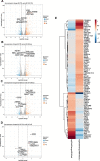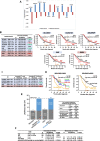Macrophages reprogramming driven by cancer-associated fibroblasts under FOLFIRINOX treatment correlates with shorter survival in pancreatic cancer
- PMID: 38167013
- PMCID: PMC10759487
- DOI: 10.1186/s12964-023-01388-7
Macrophages reprogramming driven by cancer-associated fibroblasts under FOLFIRINOX treatment correlates with shorter survival in pancreatic cancer
Abstract
Background: Pancreatic ductal adenocarcinoma (PDAC) remains a clinically challenging cancer, mainly due to limited therapeutic options and the presence of a highly prominent tumor microenvironment (TME), facilitating tumor progression. The TME is predominated by heterogeneous populations of cancer-associated fibroblasts (CAFs) and tumor associated macrophages (TAMs), in constant communication with each other and with tumor cells, influencing many tumoral abilities such as therapeutic resistance. However how the crosstalk between CAFs and macrophages evolves following chemotherapeutic treatment remains poorly understood, limiting our capacity to halt therapeutic resistance.
Methods: We combined biological characterization of macrophages indirectly cocultured with human PDAC CAFs, under FOLFIRINOX treatment, with mRNAseq analyses of such macrophages and evaluated the relevance of the specific gene expression signature in a large series of primary PDAC patients to search for correlation with overall survival (OS) after FOLFIRINOX chemotherapy.
Results: Firstly, we demonstrated that CAFs polarize naïve and M1 macrophages towards an M2-like phenotype with a specific increase of CD200R and CD209 M2 markers. Then, we demonstrated that CAFs counteract the pro-inflammatory phenotype induced by the FOLFIRINOX on Macrophages. Indeed, we highlighted that, under FOLFIRINOX, CAFs limit the FOLFIRINOX-induced cell death of macrophages and further reinforce their M2 phenotype as well as their immunosuppressive impact through specific chemokines production. Finally, we revealed that under FOLFIRINOX CAFs drive a specific macrophage gene expression signature involving SELENOP and GOS2 that correlates with shortened OS in FOLFIRINOX-treated PDAC patients.
Conclusion: Our study provides insight into the complex interactions between TME cells under FOLFIRINOX treatment. It suggests potential novel candidates that could be used as therapeutic targets in combination with FOLFIRINOX to prevent and alleviate TME influx on therapeutic resistance as well as biomarkers to predict FOLFIRINOX response in PDAC patients. Video Abstract.
Keywords: Chemoresistance; FOLFIRINOX; Intercellular communication; Pancreatic cancer; Tumor-associated macrophages; cancer-associated fibroblasts.
© 2023. The Author(s).
Conflict of interest statement
The authors declare no competing interests
Figures





Similar articles
-
Cancer-associated fibroblasts promote M2 polarization of macrophages in pancreatic ductal adenocarcinoma.Cancer Med. 2017 Feb;6(2):463-470. doi: 10.1002/cam4.993. Epub 2017 Jan 18. Cancer Med. 2017. PMID: 28097809 Free PMC article.
-
CALB2 drives pancreatic cancer metastasis through inflammatory reprogramming of the tumor microenvironment.J Exp Clin Cancer Res. 2024 Oct 3;43(1):277. doi: 10.1186/s13046-024-03201-w. J Exp Clin Cancer Res. 2024. PMID: 39358777 Free PMC article.
-
Depicting the cellular complexity of pancreatic adenocarcinoma by Imaging Mass Cytometry: focus on cancer-associated fibroblasts.Front Immunol. 2024 Nov 7;15:1472433. doi: 10.3389/fimmu.2024.1472433. eCollection 2024. Front Immunol. 2024. PMID: 39575252 Free PMC article.
-
The function of microRNA related to cancer-associated fibroblasts in pancreatic ductal adenocarcinoma.Biochem Pharmacol. 2025 Jun;236:116849. doi: 10.1016/j.bcp.2025.116849. Epub 2025 Mar 6. Biochem Pharmacol. 2025. PMID: 40056941 Review.
-
Fibroblasts in pancreatic cancer: molecular and clinical perspectives.Trends Mol Med. 2023 Jun;29(6):439-453. doi: 10.1016/j.molmed.2023.03.002. Epub 2023 Apr 24. Trends Mol Med. 2023. PMID: 37100646 Review.
Cited by
-
Unveiling the contribution of tumor-associated macrophages in driving epithelial-mesenchymal transition: a review of mechanisms and therapeutic Strategies.Front Pharmacol. 2024 Sep 2;15:1404687. doi: 10.3389/fphar.2024.1404687. eCollection 2024. Front Pharmacol. 2024. PMID: 39286635 Free PMC article. Review.
-
Unraveling the glyco-immunity nexus in pancreatic cancer.Mol Cancer. 2025 Aug 4;24(1):211. doi: 10.1186/s12943-025-02417-4. Mol Cancer. 2025. PMID: 40759948 Free PMC article. Review.
-
New Strategies for Macrophage Re-Education in Cancer: An Update.Int J Mol Sci. 2024 Mar 18;25(6):3414. doi: 10.3390/ijms25063414. Int J Mol Sci. 2024. PMID: 38542388 Free PMC article. Review.
-
Anti-CTGF/PD-1 bispecific antibody Y126S restrains desmoplastic and immunosuppressive microenvironment in pancreatic cancer.J Immunother Cancer. 2025 Jun 13;13(6):e012144. doi: 10.1136/jitc-2025-012144. J Immunother Cancer. 2025. PMID: 40514068 Free PMC article.
-
Increased Herpesvirus Entry Mediator Expression on Circulating Monocytes and Subsets Predicts Poor Outcomes in Pancreatic Ductal Adenocarcinoma Patients.Int J Mol Sci. 2025 Mar 21;26(7):2875. doi: 10.3390/ijms26072875. Int J Mol Sci. 2025. PMID: 40243455 Free PMC article.
References
Publication types
MeSH terms
Substances
LinkOut - more resources
Full Text Sources
Medical
Molecular Biology Databases
Miscellaneous

